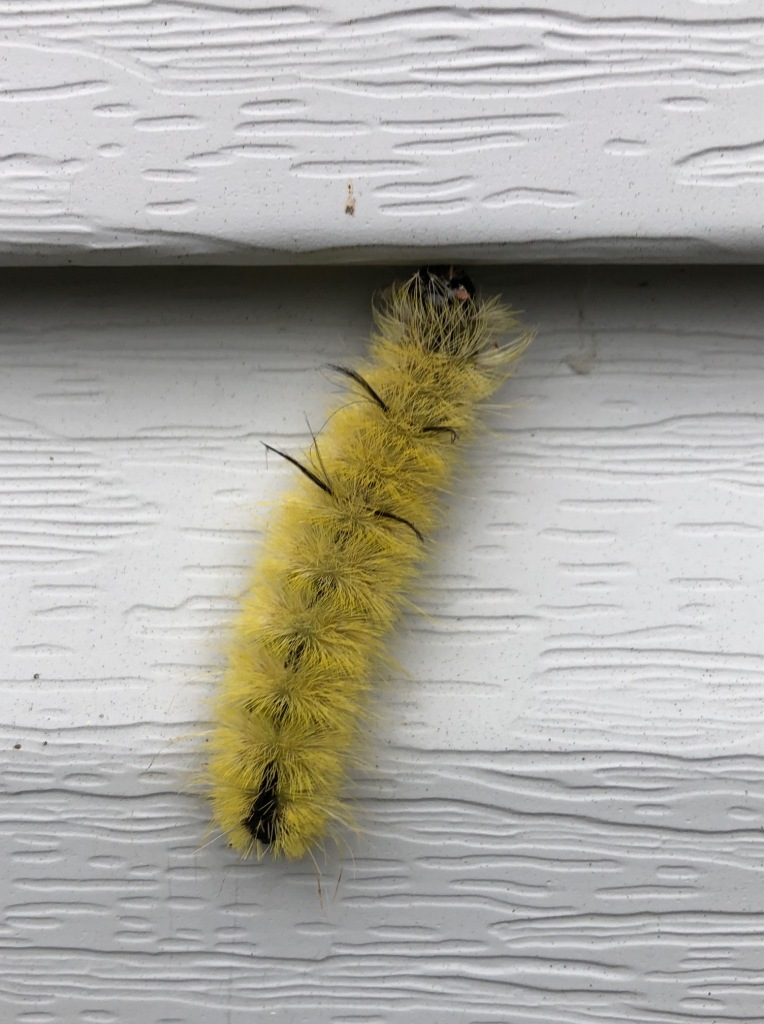
I grabbed my phone and dashed outside to take pictures.
I didn’t need to be quiet or stealthy or dressed in camouflage. My prey wasn’t a squirrel or bird or bunny, and it was still there after I ran around the back of the house and entered the front yard.
I’d spotted the neon-yellow, fuzzy caterpillar with four black spikes through my kitchen window, a gateway to what I think of as an urban wildlife reserve in my front yard.
The caterpillar was oblivious to me while I snapped pictures. Next, I opened an app on my phone that lets me submit a picture of an animal, insect, or plant then identifies my subject. (This kind of stuff reminds me of watching Star Trek in the 1960s.)
My app revealed that the neon-yellow critter would become an American dagger moth. The moth’s markings are pretty—a symmetrical combination of geometrics and zigzags, but its coloring—shades of black to pale gray—give a gloomy, mysterious vibe. Cloak and dagger, I thought, imagining a tiny dagger concealed under the cloak of each wing.
I wondered, Why the name dagger? and What did it eat? and What ate it?
James Baker, Professor Emeritus of North Carolina State, explains the name dagger comes from the patterns on its forewings, which look like tiny daggers “if you have a good imagination.” I don’t see it, but I still think I’ve got a good imagination—remember my fantasy about moths concealing tiny daggers.
My research revealed it’s not a good idea to touch or pick up these fluffy caterpillars because they can cause skin irritations. I never contemplated picking it up. Doesn’t matter how adorable an insect is, I don’t touch it.
American dagger caterpillars eat the leaves of hardwood trees like maple, and there are three mature maples my yard. I couldn’t find any information about what eats the caterpillar. But after reading about caterpillars that sting or cause skin irritations, I’m guessing nothing does. It’s bright color and black spines serve notice to predators—danger, danger, warning—do not eat. However, bats and birds and lots of other critters eat American dagger moths in both its larvae and adult stages.
Research suggested that if you want to get rid of dagger moth caterpillars, brush them away with a broom or step on them (warning—not barefooted!) or treat your yard with a landscape insecticide. Given that dagger moth caterpillars rarely travel in marauding herds, this sounded like shooting a fly with a cannon or lighting a candle with a blowtorch or grating cheese with a chainsaw. People tend to see only one or two of them at a time. I’ve only seen one all summer.
A better idea is to understand the importance larvae and moths (and benign caterpillars) have in the food chain. A better idea is to live together with nature. A better idea is to abandon the idea of perfect lawns and landscapes sponsored by too many chemicals.

I don’t blame you — I wouldn’t have picked it up, either!
LikeLike
I don’t pick anything up, but I like my phone app because I like learning about all the small pieces of nature and how important they are to the big pieces of nature.
LikeLike
Beautiful article about dagger caterpillar. Before your blog I really didn’t know it calls dagger for pattern of its forewings. Well shared 👌😊💐 thank you,,🌹🍫
LikeLike
Wow, the only furry caterpillar I have ever seen is the woolly bear (which becomes the Isabella Tiger moth, so I wanted to see what kind of a moth the dagger caterpillar turns into ~ its kind of an ugly gray. I was surprised that it wasn’t more colorful. Great essay on a new (to me) creepy crawly!
LikeLiked by 1 person
Thanks. Lovely pic (and I don’t pick up anything, either). How thoughtful and informative.
LikeLiked by 1 person
Thank you!
LikeLiked by 1 person
Pingback: It’s National Moth Week | Writing Near the Lake